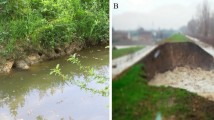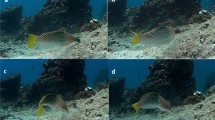Synopsis
During 22 daylight submersible dives in August 1979 numerous juvenile and adult tilefish, Lopholatilus chamaeleonticeps, were observed in and around vertical burrows in the clay substrate of portions of Hudson submarine canyon in depths from 110–230 m. The size and shape of the burrows varied considerably with the smallest juveniles occupying simple vertical shafts in the substrate. Larger fish were found in much larger burrows (up to 4–5 m in diameter and at least 2–3 m deep) that were funnel shaped in cross-section with the upper conical portions containing numerous smaller burrows of associated crabs. The range of burrow sizes observed suggests a regular sequence of burrow construction by tilefish and the associated crabs. Both juvenile and adult tilefish swam into the burrows head first and exited tail first. This behavior, which would preclude the possibility of ambushing prey, and evidence of predation by sharks and other tilefish, suggests that the burrow is a refuge from predators.
Tilefish burrows appear to serve as a focus for biological activity. Species associated with the burrows included galatheid crabs, Cancer sp., Acanthocarpus alexandri, Homarus americanus, Heliocolenus dactylopterus and Conger oceanicus. Tilefish may play an important role in structuring outer continental shelf communities. They physically shape their environment and probably have significant biological interactions with the species that associate with their burrows.
Similar content being viewed by others
References cited
Atkinston, R.J.A., R.S.U. Pullin & F.A. Dipper. 1977. Studies on the red band fish, Cepola rubescens. J. Zool. Lond. 182: 369–384.
Brothers, E.B. 1975. The comparative ecology and behavior of three sympatric California gobies. Ph.D. Thesis, Univ. of California, San Diego. 370 pp.
Clark, E. 1971. The Red Sea garden eel. Underwater Nat. 7: 4–10.
Clark, E. & A. Ben-Tuvia. 1973. Red Sea fishes of the family Branchiostegidae with a description of a new genus and species Asymmetrurus oreni. Sea Fish. Res. Stn. Haifa 60: 1–12.
Clifton, H.E. & R.E. Hunter. 1972. The sand tilefish. Malacanthus plumieri, and the distribution of course debris near West Indian Coral reefs. pp.87–92. In: B.B. Collette & S.A. Earle (ed.) Results of the Tektite Program: Ecology of Coral Reef Fishes, Los Angeles County Mus. Sci. Bull. 14.
Colin, P.L. 1971. Interspecific relationships of the yellowhead jawfish, Opistognathus aurifrons (Pisces, Opistognathidae). Copeia 1971: 469–473..
Colin, P.L. 1972. Daily activity patterns and effects of environmental conditions on the behavior of the yellowhead jawfish, Opistognathus aurifrons, with notes on its ecology. Zoologica 57: 193–421.
Colin, P.L. 1973. Burrowing behavior of the yellowhead jawfish, Opistognathus auriforms, Copeia 1973: 84–90.
Colin, P.L. & D.W. Arneson. 1978. Aspects of the natural history of the swordtail jawfish, Lonchopisthus micrognathus (Poey) (Pisces: Opistognathidae), in southwestern Puerto Rico. J. Nat. Hist. 12: 689–697.
Cooper, R.A. & J.R. Uzmann. 1977. Ecology of juvenile and adult clawed lobsters, Homarus americanus, Homarus gammarus, and Nephrops norvegicus. pp 187–208. In: B.F. Phillips & J.S. Cobb (ed.) Workshop on Rock Lobster Ecology and Physiology, Commonwealth Scientific and Industrial Research Organization, Div. of Fish. and Ocean, Circ. No. 7.
Dooley, J.K. 1978. Systematics and biology of the tilefishes (Perciformes: Branchiostegidae and Malacanthidae) with descriptions of two new species. NOAA Tech. Rept. NMFS Circ. 411: 1–78.
Emery, A. 1973. Biological survey — summer expedition. pp. 16–23. Arctic diving, Advisory Committee on Northern Development north of 60° N. Vol. IV.
Fricke, H.W. 1970. Ökologische und verhaltensbiologische Beobachtungen an den Röhrenaalen Gorgasia sillneri und Taeniconger hassi (Pisces, Apodes, Heterocongridae). Z. Tierpsychol. 27: 1076–1099.
Gordon, J.D.M. & J.A.R. Duncan. 1979. Some notes on the biology of the snake blenny, Lumpenus lampretaeformis, on the west coast of Scotland. J. Mar. Biol. Ass. U.K. 59: 413–419.
Grimes, C.B., K.W. Able & S.C. Turner. 1980. Preliminary catch and fishing effort studies of tilefish, Lopholatilus chamaeleonticeps, in the Mid-Atlantic Bight. Mar. Fish. Rev. 42 13–18.
Grimes, C.B., K.W. Able & S.C. Turner. 1982. Direct observation from a submersible vessel of commercial longlines for tilefish. Trans. Amer. Fish. Soc. 111: 94–98.
Hoese, D.F & G.R. Allen. 1977. Signigobius biocellatus, a new genus and species of sand-dwelling coral reef gobid fish from the western tropical Pacific. Jap. J. Ichthyol. 23: 199–207.
Knebel, H.J. 1979. Anomalous topography on the continental shelf around Hudson canyon. Mar. Geology 33: M67–M95.
Paulson, A.C. 1978. On the commensal habits of Ptereleotris, Acanthuris, and Zebrasoma with fossorial Valenciennea and Amblygobius. Copeia 1978: 168–169.
Randall, J.E. & J.K. Dooley. 1974. Revision of the Indo-Pacific branchiostegid fish genis Hoploatilus, with descriptions of two new species. Copeia 1974: 457–471..
Rice, A.L. & A.D.F. Johnstone. 1972. The burrowing behavior of the gobiid fish Lesuerigobius friesii (Collett). Z. Tierpsychol. 30: 431–438.
Robb, J.M., J.C. Hampson, & D.C. Twichell. 1981. Geomorphology and sediment stability of a segment of the U.S. continental slope off New Jersey. Science 211: 935–937.
Stanley, D.J. 1971. Fish-produced markings on the outer continental margin east of the Middle Atlantic states. J. Sed. Petrol. 41: 159–170.
Stanley, D.J. 1978. The erosion-deposition boundary in the head of Hudson Submarine Canyon defined on the basis of submarine observations. Mar. Geol. 26: M37–M46.
Uzmann, J.R. R.A. Cooper, R.B. Theroux & R.L. Wigley. 1977. Synoptic comparisons of three sampling techniques for estimating abundance and distribution of selected megafauna: submersible vs. camera sled vs. otter trawl. Mar. Fish. Rev. 1273: 11–19.
Valentine, P.C., J.R. Uzmann & R.A. Cooper. 1980. Geology and biology of Oceanographer submarine canyon. Mar. Geol. 38: 283–312.
Warme, J.E., R.A. Slater & R.A. Cooper. 1977. Bioerosion in submarine canyons. pp. 65–70. In: D.J. Stanley & G. Kelling.
Wiley, A. & A.G. Huntsman. 1921. Faunal notes from the Atlantic Biological Station, 1920. Canadian Field Naturalist 35: 1–7.
Author information
Authors and Affiliations
Rights and permissions
About this article
Cite this article
Able, K.W., Grimes, C.B., Cooper, R.A. et al. Burrow construction and behavior of tilefish, Lopholatilus chamaeleonticeps, in Hudson Submarine Canyon. Environ Biol Fish 7, 199–205 (1982). https://doi.org/10.1007/BF00002496
Received:
Accepted:
Issue Date:
DOI: https://doi.org/10.1007/BF00002496




